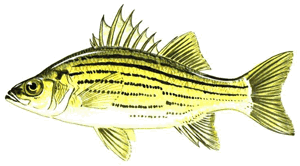Back to Previous Page
YELLOW BASS

At-a-Glance
- Scientific Name: Morone mississippiensis
- Found in Illinois: Statewide
- State Average: 6.5"
- State Record: 2 lbs (1994); hybrid: 2 lbs/.96 oz. (2008)
- Best Lures: minnows, worms, small spinners, and small jigs with twister tails
The majority of yellow bass caught are taken on live baits such as minnows, garden worms and night crawlers. Cut baits are also very good at times. Occasionally spinner-baits or spinner fly combinations and small plugs are productive when trolled near the bottom. When the fish are in shallow water, spinners, spoons, flys and poppers are effective. These fish generally travel in schools, and once located, they are easily caught by still-fishing with the above natural baits.
Best fishing usually occurs in the spring and early summer around brushy areas and submerged weed beds. During the heat of summer, fishing is usually poor but picks up after the water cools in the fall.
Habitat: The yellow bass is both commonly found in the larger rivers, such as the Illinois and Mississippi River, their backwaters, and adjoining bottomland lakes and major tributaries. They are also found in some of the natural lakes in Northeastern Illinois. The yellow bass can be found in many of our farm ponds, city water supply lakes, large artificial impoundments and natural lakes as a result of natural entry, experimental stocking or stocking by the public.
Feeding and Habits: The diet of the adult yellow bass consists of small yellow perch, bluegill, gizzard shad, crayfish and larger insects.
Reproduction: Spawning of the yellow bass usually takes place in April or early May. The very small eggs are deposited over gravel bars, rocky reefs or underwater brush and weeds in shallow water. These fish generally mature in the third year when they are seven to nine inches long, but faster growing fish may mature in the second year.



